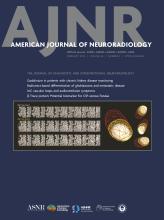Research ArticleUltra-High-Field MRI/Imaging of Epilepsy/Demyelinating Diseases/Inflammation/Infection
Dynamic Expansion and Contraction of Multiple Sclerosis T2-Weighted Hyperintense Lesions Are Present below the Threshold of Visual Perception
Darin T. Okuda, Tatum M. Moog, Morgan McCreary, Kevin Shan, Kasia Zubkow, Braeden D. Newton, Alexander D. Smith, Mahi A. Patel, Katy W. Burgess and Christine Lebrun-Frénay
American Journal of Neuroradiology February 2025, 46 (2) 443-450; DOI: https://doi.org/10.3174/ajnr.A8453
Darin T. Okuda
aFrom the Department of Neurology, Neuroinnovation Program, Multiple Sclerosis & Neuroimmunology Imaging Program (D.T.O., T.M.M., M.M., M.A.P., K.W.B.), The University of Texas Southwestern Medical Center, Dallas, Texas
bPeter O’Donnell Jr. Brain Institute (D.T.O., T.M.M., M.M., M.A.P., K.W.B.), The University of Texas Southwestern Medical Center, Dallas, Texas
Tatum M. Moog
aFrom the Department of Neurology, Neuroinnovation Program, Multiple Sclerosis & Neuroimmunology Imaging Program (D.T.O., T.M.M., M.M., M.A.P., K.W.B.), The University of Texas Southwestern Medical Center, Dallas, Texas
bPeter O’Donnell Jr. Brain Institute (D.T.O., T.M.M., M.M., M.A.P., K.W.B.), The University of Texas Southwestern Medical Center, Dallas, Texas
Morgan McCreary
aFrom the Department of Neurology, Neuroinnovation Program, Multiple Sclerosis & Neuroimmunology Imaging Program (D.T.O., T.M.M., M.M., M.A.P., K.W.B.), The University of Texas Southwestern Medical Center, Dallas, Texas
bPeter O’Donnell Jr. Brain Institute (D.T.O., T.M.M., M.M., M.A.P., K.W.B.), The University of Texas Southwestern Medical Center, Dallas, Texas
Kevin Shan
cSchool of Medicine (K.S.), The University of Texas Southwestern Medical Center, Dallas, Texas
Kasia Zubkow
dDivision of Neurology (K.Z.), University of Saskatchewan, Saskatoon, Saskatchewan, Canada
Braeden D. Newton
eDivision of Neurosurgery (B.D.N.), University of Saskatchewan, Saskatoon, Saskatchewan, Canada
Alexander D. Smith
fSchool of Medicine (A.D.S), Texas Tech University Health Sciences Center, Lubbock, Texas
Mahi A. Patel
aFrom the Department of Neurology, Neuroinnovation Program, Multiple Sclerosis & Neuroimmunology Imaging Program (D.T.O., T.M.M., M.M., M.A.P., K.W.B.), The University of Texas Southwestern Medical Center, Dallas, Texas
bPeter O’Donnell Jr. Brain Institute (D.T.O., T.M.M., M.M., M.A.P., K.W.B.), The University of Texas Southwestern Medical Center, Dallas, Texas
Katy W. Burgess
aFrom the Department of Neurology, Neuroinnovation Program, Multiple Sclerosis & Neuroimmunology Imaging Program (D.T.O., T.M.M., M.M., M.A.P., K.W.B.), The University of Texas Southwestern Medical Center, Dallas, Texas
bPeter O’Donnell Jr. Brain Institute (D.T.O., T.M.M., M.M., M.A.P., K.W.B.), The University of Texas Southwestern Medical Center, Dallas, Texas
Christine Lebrun-Frénay
gCRCSEP (C.L-F., Université Nice Cote d’Azur, Nice, France

References
- 1.↵
- 2.↵
- 3.↵
- McFarland HF,
- Frank JA,
- Albert PS, et al
- 4.↵
- 5.↵
- Trapp BD,
- Peterson J,
- Ransohoff RM, et al
- 6.↵
- Comi G,
- Kappos L,
- Selmaj KW, et al
- 7.↵
- Cohen JA,
- Comi G,
- Selmaj KW, et al
- 8.↵
- 9.↵
- 10.↵
- 11.↵
- 12.↵
- 13.↵
- 14.↵
- 15.↵
- 16.↵
- Nyul LG,
- Udupa JK,
- Zhang X
- 17.↵
- Caselles V,
- Kimmel R,
- Sapiro G
- 18.↵
- Cole TJ
- 19.↵
- Cole TJ
- 20.↵
- Hothorn T,
- Bretz F,
- Westfall P
- 21.↵
- 22.↵
- Fisniku LK,
- Brex PA,
- Altmann DR, et al
- 23.↵
- 24.↵
- 25.↵
- 26.↵
- 27.↵
- Adelson EH
- 28.↵
- 29.↵
- Lotto RB,
- Williams SM,
- Purves D
- 30.↵
- 31.↵
- 32.↵
- Roe AW,
- Lu HD,
- Hung CP
- 33.↵
- Albright TD,
- Stoner GR
- 34.↵The IFNB Multiple Sclerosis Study Group. Interferon beta-1b is effective in relapsing-remitting multiple sclerosis. I. Clinical results of a multicenter, randomized, double-blind, placebo-controlled trial. Neurology 1993;43:655 doi:10.1212/WNL.43.4.655
- 35.↵
- Jacobs LD,
- Cookfair DL,
- Rudick RA, et al
- 36.↵
- Johnson KP,
- Brooks BR,
- Cohen JA, et al
- 37.↵Randomised double-blind placebo-controlled study of interferon beta-1a in relapsing/remitting multiple sclerosis. PRISMS (Prevention of Relapses and Disability by Interferon beta-1a Subcutaneously in Multiple Sclerosis) Study Group. Lancet 1998;352:1498–504
- 38.↵
- 39.↵
- Reich DS,
- Arnold DL,
- Vermersch P, et al
- 40.↵
- 41.↵
- 42.↵
- 43.↵
- Prineas JW,
- Connell F
- 44.↵
- 45.↵
- 46.↵
In this issue
American Journal of Neuroradiology
Vol. 46, Issue 2
1 Feb 2025
Advertisement
Darin T. Okuda, Tatum M. Moog, Morgan McCreary, Kevin Shan, Kasia Zubkow, Braeden D. Newton, Alexander D. Smith, Mahi A. Patel, Katy W. Burgess, Christine Lebrun-Frénay
Dynamic Expansion and Contraction of Multiple Sclerosis T2-Weighted Hyperintense Lesions Are Present below the Threshold of Visual Perception
American Journal of Neuroradiology Feb 2025, 46 (2) 443-450; DOI: 10.3174/ajnr.A8453
0 Responses
Dynamic MS Lesion Changes Beyond Visual Perception
Darin T. Okuda, Tatum M. Moog, Morgan McCreary, Kevin Shan, Kasia Zubkow, Braeden D. Newton, Alexander D. Smith, Mahi A. Patel, Katy W. Burgess, Christine Lebrun-Frénay
American Journal of Neuroradiology Feb 2025, 46 (2) 443-450; DOI: 10.3174/ajnr.A8453
Jump to section
Related Articles
Cited By...
- No citing articles found.
This article has not yet been cited by articles in journals that are participating in Crossref Cited-by Linking.
More in this TOC Section
Similar Articles
Advertisement











